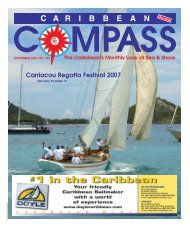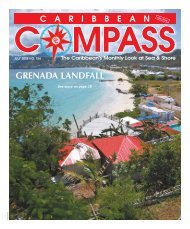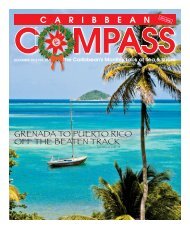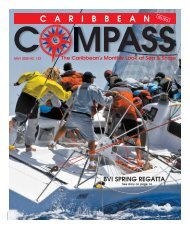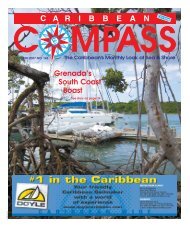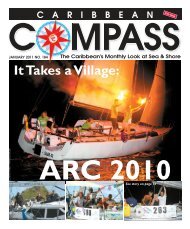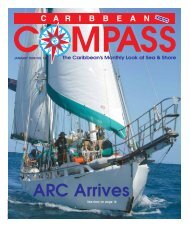You also want an ePaper? Increase the reach of your titles
YUMPU automatically turns print PDFs into web optimized ePapers that Google loves.
WORLD<br />
Heritage Sites are locations of cultural and natural<br />
heritage considered to be of outstanding value<br />
to humanity. There are currently 878 around the<br />
globe. Those in the <strong>Caribbean</strong> region include the Barrier Reef Reserve System,<br />
Belize; the Port, Fortresses and Group of Monuments, Cartagena, Colombia; Old<br />
Havana and its Fortifications, Cuba; Morne Trois Pitons National Park, Dominica;<br />
Colonial City of Santo Domingo, Dominican Republic; National History Park (Citadel,<br />
Sans Souci, Ramiers), Haiti; Historic Area of Willemstad (Inner City and Harbour),<br />
Curaçao, Netherlands Antilles; Fortifications on the<br />
<strong>Caribbean</strong> Side of Panama (Portobelo-San Lorenzo);<br />
Brimstone Hill Fortress National Park, St. Kitts &<br />
Nevis; Pitons Management Area, St. Lucia; Historic<br />
Inner City of Paramaribo, Suriname; and Coro and its<br />
Port, Venezuela.<br />
The idea of establishment of a Grenadine Islands<br />
World Heritage Site is gaining momentum.<br />
The United Nations Educational, Scientific and<br />
Cultural Organization (UNESCO) seeks to encourage<br />
the identification, protection and preservation of cultural<br />
and natural heritage around the world, through a<br />
treaty called the Convention Concerning the Protection<br />
of the World Cultural and Natural Heritage. As of April<br />
<strong>2009</strong>, 186 nations have ratified the Convention.<br />
UNESCO is currently looking for sites in under-represented<br />
regions, which includes the <strong>Caribbean</strong>, and<br />
nations which as yet have no designated sites, such as<br />
Grenada and St. Vincent & the Grenadines.<br />
UNESCO will help safeguard World Heritage sites by<br />
providing technical assistance and professional training;<br />
providing emergency assistance for sites in immediate<br />
danger; and supporting public awareness-building activities<br />
for conservation.<br />
To be included on the World Heritage List, sites must be of outstanding<br />
universal value and meet at least one out of ten selection<br />
criteria. Among the criteria which the Grenadines might meet are:<br />
• to be an outstanding example of a traditional human settlement,<br />
land-use, or sea-use which is representative of a culture (or cultures),<br />
or human interaction with the environment especially when it has<br />
become vulnerable under the impact of irreversible change;<br />
• to contain superlative natural phenomena or areas of exceptional<br />
natural beauty and aesthetic importance;<br />
• to be outstanding examples representing major stages of earth’s history, including<br />
the record of life, significant on-going geological processes in the development of<br />
landforms, or significant geomorphic or physiographic features;<br />
• to be outstanding examples representing significant on-going ecological and biological<br />
processes in the evolution and development of terrestrial, fresh water, coastal<br />
and marine ecosystems and communities of plants and animals.<br />
The Grenadines have considerable strength in both natural and cultural heritage. It<br />
has diverse marine habitats, including the most extensive area of coral reefs in the<br />
Grenadines<br />
Next World<br />
Heritage<br />
Site?<br />
southeastern <strong>Caribbean</strong>. Present are also seagrass beds and mangrove, and it is a<br />
significant larval production area. The area is a breeding ground for whales. Terrestrial<br />
biodiversity is emerging as important also. There are several terrestrial endemic species,<br />
and the finding of a new species of lizard on Union Island is an example of what<br />
might be revealed with further investigation. The Grenadine Islands are excellent<br />
global examples of small archipelagic islands during their early days of geological evolution.<br />
They contain examples of the most active underwater volcanoes with associated<br />
endemic biodiversity along a subduction zone. Culturally, there is a wealth of pre-<br />
Columbian sites yet to be explored, traditions of boat<br />
building, sailing and whaling, well-preserved African<br />
traditions such as Big Drum and maroon festivals, and<br />
colonial forts, all within this relatively small area. The<br />
How special is this? Many feel that the interaction of the<br />
Grenadines’ people and environment has formed a unique<br />
cultural landscape that deserves World Heritage status<br />
Grenadines is an area of outstanding beauty.<br />
In February 2006, representatives from 15 <strong>Caribbean</strong><br />
countries participated in a regional training workshop<br />
on World Heritage held in St. Lucia, to<br />
raise awareness on nominating marine<br />
areas from the <strong>Caribbean</strong> as World<br />
Heritage Sites. The participants recognized<br />
that by collaborating with other<br />
States, the chances of meeting the<br />
strict World Heritage requirements are<br />
greatly enhanced. At the same time<br />
such collaboration will help in better<br />
conserving the natural features in<br />
question.<br />
Preliminary meetings regarding the<br />
Grenadines of St. Vincent & the<br />
Grenadines of Grenada joining to form<br />
a single World Heritage Site were held<br />
by the Sustainable Grenadines Project<br />
(SusGren) in both countries during<br />
September 2008. SusGren (www.cavehill.uwi.edu/cermes/susgrenadines-<br />
Index.html) is a trans-boundary initiative<br />
looking to strengthen and empower<br />
local communities in protecting<br />
their environment and livelihoods in<br />
the Grenadines.<br />
On March 17th, <strong>2009</strong>, with UNESCO<br />
support, SusGren hosted a workshop<br />
in St. Vincent with the aim of developing a joint effort between Grenada and St.<br />
Vincent & the Grenadines to approach both Governments on the relevant issues, pursuing<br />
support from UNESCO, and preparing a position paper on the possibility of the<br />
Grenadines becoming a World Heritage Site to submit to Cabinet in both countries.<br />
The 30 participants, coming from relevant government ministries and NGOs in both<br />
countries, agreed that the Grenadine Islands have the potential to become a World<br />
Heritage Site, and working groups were formed to plan strategy to pursue the goal.<br />
For more information on World Heritage Sites visit http://whc.unesco.org/.<br />
DAVON BAKER<br />
MAY <strong>2009</strong> CARIBBEAN COMPASS PAGE 11





